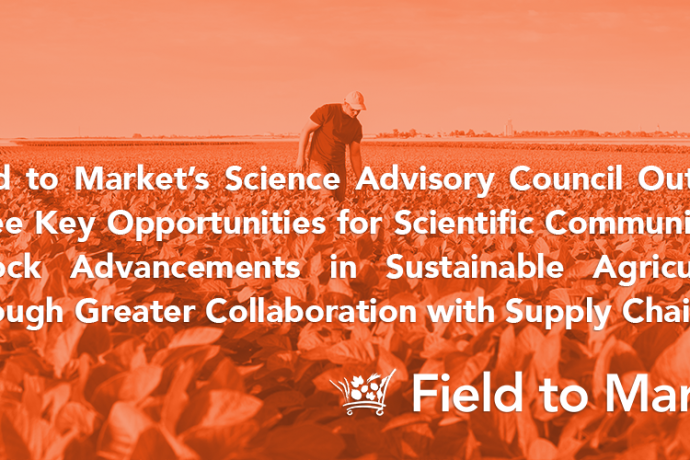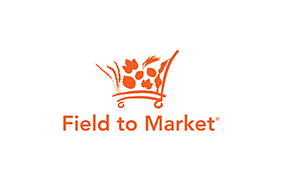Field to Market’s Science Advisory Council Outlines Three Key Opportunities for Scientific Community to Unlock Advancements in Sustainable Agriculture Through Greater Collaboration with Supply Chain
Published 07-13-17
Submitted by Field to Market: The Alliance for Sustainable Agriculture

In a paper published today in Agriculture and Environmental Letters, Field to Market: The Alliance for Sustainable Agriculture’s Science Advisory Council explores the role of science in quantifying environmental impacts from agricultural production and outlines opportunities for the scientific community to unlock advancements in sustainable agriculture through greater collaboration with the supply chain. Highlighting that a divide between scientific research and agronomic practices needs to be bridged, the Council outlines the keys to implementing effective change at a broad scale for U.S. agriculture, which include:
Improving the representation of complex environmental systems in simulation models for field-level feedback;
Expanding the understanding of environmental impacts across scales, and quantification and communication of uncertainty at relevant scales; and
Increasing the knowledge base around how agricultural practices influence environmental outcomes at and beyond the field scale.
“Consumers and corporations are increasingly interested in understanding the sustainability of agricultural supply chains and reducing the environmental impacts of food, fiber, feed, and fuel production,” said Allison Thomson, Field to Market’s Science & Research Director and lead author of the paper. “The more robust our understanding of the science becomes, the greater the potential for changes that significantly improve environmental outcomes at local, regional, and national levels.”
The Science Advisory Council evaluated changes over the past 35 years in key environmental impacts of crop production across five national sustainability indicators for nine crops (barley, corn, cotton, peanuts, potatoes, rice, soybeans, sugar beets, and wheat). Utilizing publicly available data from USDA surveys of farm land, production, and practices, the Council calculated indicators for land use, water use, energy use, greenhouse gas (GHG) emissions and soil erosion from 1980 to 2015.
The main conclusion from this long-term analysis is that in comparison to 1980, more food, fiber and feed are being produced with fewer resources. These improvements resulted from higher crop yields achieved through improved plant genetics and breeding as well as management changes. However, the paper outlines that for these trends to continue, agriculture must overcome two fundamental challenges: (1) in some regions, yield improvements may be approaching a biophysical ceiling for current crop varieties as determined by climate and soil properties; and (2) aggregate improvements in efficiency on a per-unit of production basis may be outweighed by increases in production.
“To unlock further advancements in sustainable agriculture, collaboration between the scientific research community and sustainable agriculture practitioners is vital to both further scientific understanding and implement effective change at a broad scale for U.S. agriculture,” stated Chris van Kessel, distinguished professor, University of California-Davis Department of Plant Sciences, co-author of the paper and member of Field to Market’s Science Advisory Council. “Insights from changes in agricultural practices can be effectively used to enhance and inform research needs and insights.”
Supporting the efforts of actors across the food and agricultural value chain to deliver sustainable outcomes for agriculture requires input and collaboration with the scientific community to ensure that recommended management changes lead to real improvements. Achieving improvements will only be possible if key gaps are addressed regarding available simulation models and data; scale of implementation and uncertainty; and effectiveness of conservation practices. Bridging this divide presents an opportunity for dialogue between scientists, farmers, and private-sector stakeholders to advance scientific knowledge and promote the common objective of sustainable agriculture.
“By strengthening the connection between researchers and the private sector, enormous potential exists to bridge the gap between scientific research and agronomic practices, leading to greater advancements in the sustainability of U.S. agriculture,” shared Marlen Eve, national program leader for soil and air, Agricultural Research Service, USDA, co-author of the paper and member of Field to Market’s Science Advisory Council. “There is a significant opportunity for the scientific community to collaborate across all parts of the supply chain on research to fill in the gaps identified.”
About Field to Market
Field to Market: The Alliance for Sustainable Agriculture brings together a diverse group of grower organizations; agribusinesses; food, beverage, restaurant and retail companies; conservation groups; universities and public sector partners to focus on defining, measuring and advancing the sustainability of food, fiber and fuel production. Field to Market is comprised of more than 125 members representing all facets of the U.S. agricultural supply chain, with members employing more than 5 million people and representing combined revenues totaling over $1.5 trillion.

Field to Market: The Alliance for Sustainable Agriculture
Field to Market: The Alliance for Sustainable Agriculture
Field to Market: The Alliance for Sustainable Agriculture™ is a leading multi-stakeholder initiative working to unite the agricultural supply chain in defining, measuring and advancing the sustainability of food, feed, fiber and fuel production in the United States. We bring together a diverse group of grower organizations; agribusinesses; food, beverage, restaurant and retail companies; conservation groups; universities; and public sector partners to create opportunities across the agricultural supply chain for continuous improvements in productivity, environmental quality, and human well-being. With the world population estimated to exceed 9 billion by 2050, the entire agricultural value chain must work together to efficiently and responsibly lay the groundwork for a more sustainable future. From the farm gate to the retail and restaurant counter, the challenge of producing enough food, feed, fiber and fuel for a rapidly growing population, while conserving our planet’s natural resources has become increasingly complex. The nature of this challenge requires an unparalleled level of transparency and collaboration. By uniting the agricultural supply chain and key stakeholders around a common measurement framework, Field to Market seeks to drive continuous improvement in the sustainability of commodity crop production.
More from Field to Market: The Alliance for Sustainable Agriculture

